Tesla at the Smithsonian: The Story Behind His Genius
A new biography looks to document how the scientist thought of so many inventions, some of which are housed at the American History Museum
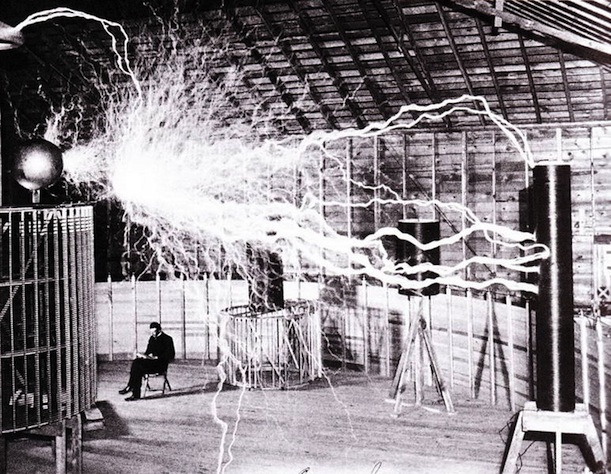
Inventor Nikola Tesla published this publicity photo, taken with a double exposure in his laboratory in Colorado Springs. Tesla had a flair for both science and celebrity. Photo courtesy of Wikimedia
When editor Arthur Brisbane first observed the Wizard, the man sworn to be greater an inventor than Edison himself, Brisbane was as impressed by what he saw as what he had heard. The Wizard, otherwise known as Nikola Tesla, had already earned a reputation for his daring experiments by the time the two met at a restaurant in Manhattan in 1894. His most shocking performance had been in an effort to demonstrate how safe his alternating currents were when Tesla allowed 250,000-volt shocks to course through his body before a disbelieving public. Noting his slim frame and tall stature, Brisbane noted, “He has big hands. Many able men do–Lincoln is one instance.” Better still were his even more prominent thumbs, after all, “the thumb is the intellectual part of the hand.” Little of Tesla was left unremarked upon, including his pale eyes, which Tesla told Brisbane had once been darker but through years of mental concentration, Tesla had lightened at his will.
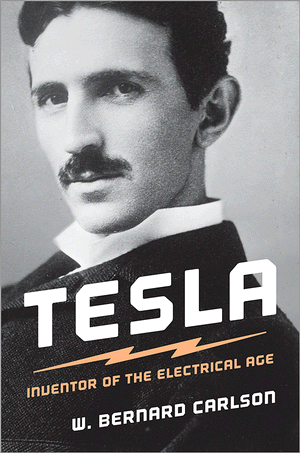
“In writing about Tesla,” explains W. Bernard Carlson, author of a new biography on the inventor, “one must navigate between unfair criticism and excessive enthusiasm.” In his new book, Tesla: Inventor of the Electrical Age, Carlson examines Tesla’s many achievements and his tumultuous life that earned him the reputation of mad scientist.
In recent years, Tesla has come back into vogue. A Drunk History episode had John C. Reilly portray him as a man constantly frustrated and eclipsed by bigger names. The flashiest of futurist car companies, Elon Musk’s Tesla Motors, borrowed the inventor’s name for its high-tech models. He’s even getting his own opera, created by Jim Jarmusch and commissioned by Dartmouth College. When Matthew Inman of The Oatmeal published a comic titled “Why Nikola Tesla was the greatest geek who ever lived,” Forbes came to the defense of Thomas Edison–slammed by Inman as a CEO, rather than a geek–and fueled a debate that is still going strong. Inman found plenty of pro-Tesla allies and helped crowd-fund the purchase of Tesla’s Long Island laboratory by the non-profit Tesla Science Center at Wardenclyffe group, with plans to turn it into a museum.
Born to Serbian parents in 1856 on the outskirts of the Austro-Hungarian empire in what is today Croatia, Tesla showed an early interest in math and mechanics. After surviving a bout of cholera, he enrolled in a polytechnic school in Austria, where he instantly stood out for his achievements. But the success was short-lived. He developed a gambling problem, dropped out of school and suffered a nervous breakdown, eventually moving to Budapest to work at a telegraph company. After working at Thomas Edison’s company in France, Tesla relocated to New York City to work more closely with Edison. He arrived in the United States with just four cents in his pocket. Once in New York, Tesla took up the challenge of improving Edison’s direct current motors and generators but received none of the $50,000 Edison had promised him to do so. Edison claimed it was a joke and gave him a slight raise instead. Tesla quit and formed his own company.
He would go on to earn some 300 patents around the world, help cement the technologies that formed modern AC electricity as well as radio and television. He experimented with what he called “atmospheric electricity” and claimed he invented a particle-beam weapon at one of his annual birthday celebrations. His genius also had a dark side, as Matt Novak writes for Paleofture:
Like any man, Tesla was far from perfect and sometimes had very warped ideas about how the world should operate. One of Tesla’s most disturbing ideas was his belief in using eugenics to purify the human race. In the 1930s, Tesla expressed his belief that the forced sterilization of criminals and the mentally ill — which was occurring in some European countries (most disturbingly Nazi Germany) and in many states in the U.S. — wasn’t going far enough.
As a celebrity scientist, his enigmatic personality often received and receives still more attention than his many inventions and the processes behind them. Carlson’s book seeks to correct this with a technical breakdown of Tesla’s most notable achievements. “It’s all too easy to associate invention with imponderables such as genius, mystery, and luck,” writes Carlson. “In contrast, I view invention as a process that we can analyze and understand.”
Explaining the method himself, Tesla told a crowd gathered for his Edison Medal award ceremony in 1917:
I do not rush into constructive work. When I get an idea, I start right away to build it up in my mind. I change the structure, I make improvements, I experiment, I run the device in my mind. It is absolutely the same to me whether I operate my turbine in thought or test it actually in my shop. It makes no difference, the results are the same. In this way, you see, I can rapidly develop and perfect an invention, without touching anything.
Carlson points out that this approach is quite different from that of Thomas Edison, who was known to want either the plans or the device in front of him to manipulate. To create a portrait of an inventor and his inventions, Carlson relies on schematics, letters and original documents from Tesla’s life to map out his creativity. A former fellow at the Smithsonian’s Lemelson Center, Carlson also called upon resources in the National Museum of American History’s collections to complete his research.
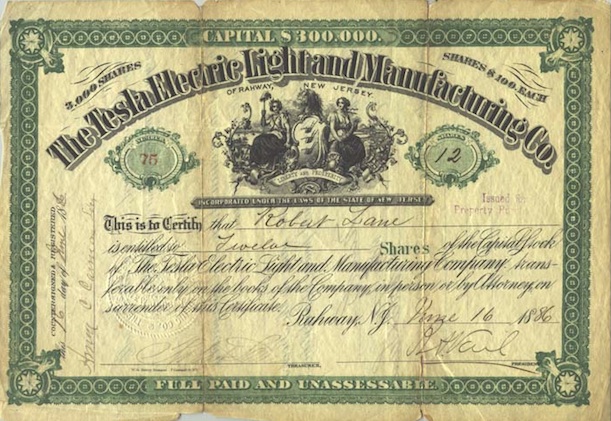
A stock share from the Tesla Electric Light and Manufacturing Company in the American History Museum’s collection.
Though many of Tesla’s creations were destroyed in a lab fire in 1895, the American History museum still has a small collection of valuable items, including four motors–two of which are currently on display–that rely on Tesla’s alternating current, a generator and nameplate from the 1895 Niagara Falls hydroelectric power station and a recently acquired stock share from Tesla’s failed Electric Light and Manufacturing Company made out to Robert Lane, the company’s treasurer. Tesla received his own stock shares when the company decided to fire him and move away from invention and into the utilities business.
“It was a very tumultuous industry,” explains Carlson. Companies struggled to figure out how to make electricity profitable, particularly with inadequate means of measuring consumption. Wall Street bankers were uninterested in the Tesla’s idea of wireless power because they could see no way to commodify it. But Tesla recognized that the money would come from the receivers, rather than the sale of the power. When his own company cut him loose, Tesla was devastated.
“He arrives in America in 1884 and this happens within basically two years of his arrival, so Tesla’s heartbroken and he doesn’t know what to do,” explains Carlson, “He basically drifts and winds up digging ditches in downtown Manhattan.”
But in what would prove to be just one of many twists of fate, Tesla’s foreman at the Western Union Telegraph Company showed an interest in the patents Tesla was hard at work on each night and introduced him to a higher-up looking to invest in new inventors. “That’s how he gets the business partners that lead to great success with the motors,” explains Carlson.
Where Edison was an adept businessman, Tesla was less so. In 1888, when Tesla is hired as a consultant at Westinghouse Electric, he finds the support of George Westinghouse.
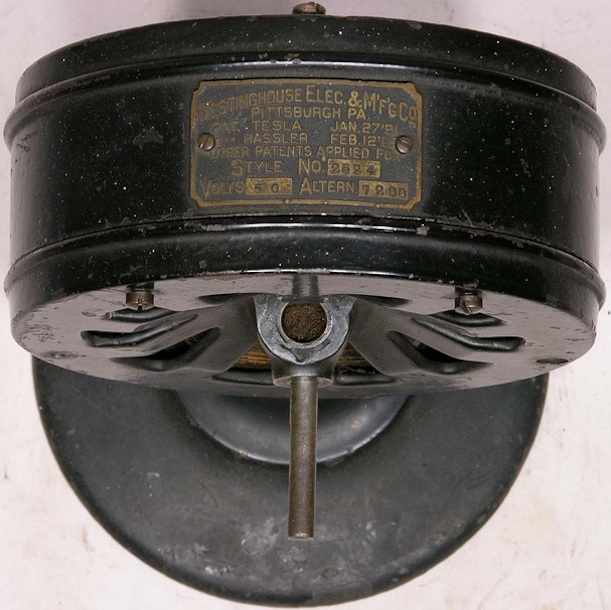
A Westinghouse motor from the American History Museum with Tesla’s patent information.
“The relationship between Tesla, the imaginative inventor and Westinghouse, the entrepreneur and capitalist, is a really good fit,” says Hal Wallace, curator of electricity at the National Museum of American History. Westinghouse bought the patents for Tesla’s polyphase AC motors and agreed to pay him $2.50 per horsepower of electrical capacity sold. Later, when Westinghouse was at the brink of demise after a costly battle for market share, Tesla tore up the contract, sacrificing his plentiful royalties so the patents would remain with Westinghouse.
Both in business and in science, Tesla proved a maverick. But Carlson cautions that this should not dissuade people from studying how exactly he came to his inventions. “Tesla always claimed that he could think through the entire invention in his head and then go and build it and it would work first time, every time,” says Carlson.
Carlson, who spent time with the American History Museum’s Kenneth Swezey Papers, which include letters, photographs and patent testimony, found that even Tesla’s genius can be analyzed and taught to future generations. “There are aspects of the creative process that remain true to this day,” says Carlson. “The number of parallels between Tesla, and say Steve Jobs, are significant and significant enough to say there are indeed patterns and things that we can learn from understanding the creative mind of somebody like Nikola Tesla.”
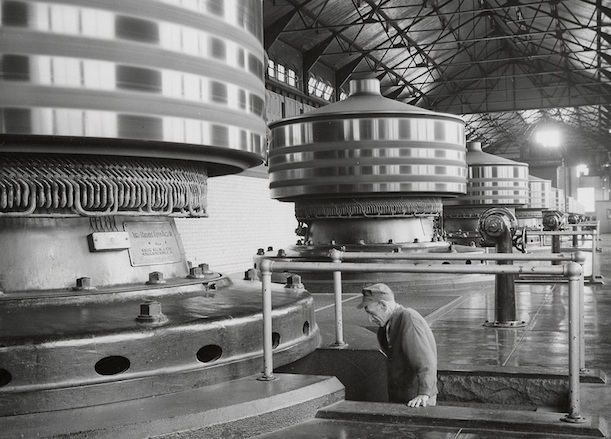
A 1953 photo of the original Westinghouse generators at the Niagara Falls power plant. Tesla and Westinghouse built the plant in 1895. From the Kenneth Swezey Papers in the Archives Center of the American History Museum.
/https://tf-cmsv2-smithsonianmag-media.s3.amazonaws.com/accounts/headshot/Leah-Binkovitz-240.jpg)
/https://tf-cmsv2-smithsonianmag-media.s3.amazonaws.com/accounts/headshot/Leah-Binkovitz-240.jpg)